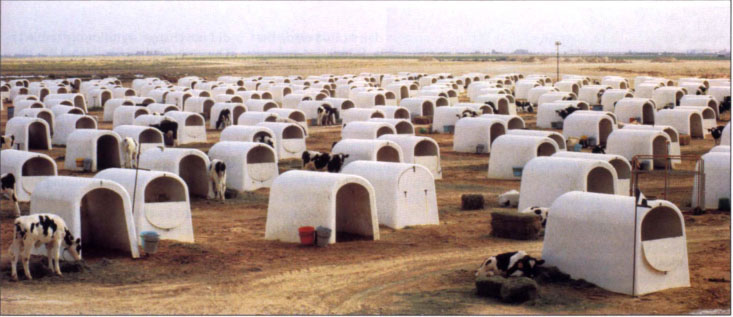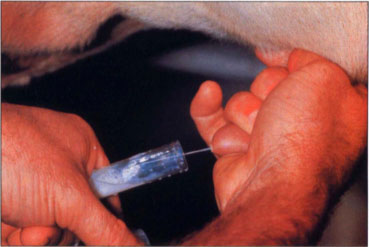All Issues
Dairies adopt TQM to improve milk quality and food safety
Publication Information
California Agriculture 53(3):33-35. https://doi.org/10.3733/ca.v053n03p33
Published May 01, 1999
PDF | Citation | Permissions
Abstract
In an effort to manage antibiotics and prevent residues in meat and milk, the principles of Total Quality Management were applied to dairy farm operations. Six California dairies participated in the National Dairy Total Quality Management Program, which included dairies in 30 states. Dairy producers, their veterinarians, the UC Cooperative Extension dairy farm advisors and Veterinary Medicine Extension veterinarians collaborated during the study. During the project, all six dairies developed written treatment plans to assure that drug withdrawal deadlines were being met. Most of the participating producers judged the management protocols, treatment protocols and treatment records to be “very useful” or “somewhat useful.” Perhaps the greatest benefit was increased communication between the dairy management and its workers for a better understanding of what was expected of each worker and who was accountable.
Full text
Calves are tethered to individual hutches, which shelter them and reduce disease transmission between animals.
In recent years, consumer concern and awareness about milk quality and food safety issues within the dairy industry have increased. The primary concerns have been about antibiotic residues and foodborne bacteria in milk. In addition, the dairy industry itself has focused on the quality of milk — high quality as indicated by low numbers of somatic cells – to ensure high-yielding products with enhanced storage life. As a result, the dairy industry has been developing quality assurance programs that ensure the continued high quality of milk products and reduce the risk of adulterated milk products.
Total Quality Management (TQM) is a management tool that is popular in the business community as a type of quality assurance program. In this case, TQM strategies were applied to dairy operations to help the dairy producers gain a better understanding of their entire production process, which impacts milk quality and food safety. These strategies employ written records, monitors, quality goals and knowledge to detect variations in the production process that affect quality and product safety. A pilot program called the National Dairy Total Quality Management Program was conducted in Colorado, Georgia, Michigan, Minnesota and Pennsylvania to test the application of the TQM concepts on dairy farms (Sischo 1995).
Calves are tethered to individual hutches, which shelter them and reduce disease transmission between animals.
Following the pilot project, 247 dairy herds from 30 states participated in a second and greatly expanded National Dairy Total Quality Management Program for milking and dry cows in 1997. Six California dairies participated in this study. Beyond the national scope of the project, our purpose was to apply the TQM principles and methods developed in the pilot project under California dairy conditions. Dairy producers, their attending veterinarians, four UCCE county dairy farm advisors and UC Davis veterinary medicine specialists worked as a team to complete the project. The focus of the project was on accountability for herd management practices; implementation of written treatment protocols and records; and monitors for discarded milk following treatment, somatic cell counts and bacteria counts.
Setting up the program
The project team consisted of the UCCE dairy farm advisors, the attending veterinarians and the Veterinary Medicine Extension specialists and a veterinary student. The dairy farm advisors and veterinarians identified the potential cooperating dairies. All six cooperating dairies were located in the Central San Joaquin Valley and were typical of California-style dairies (table 1).
An initial visit of 1 to 2 hours was made to each dairy to explain the project to the dairymen, enroll them in the project and complete the entrance survey. We provided forms that we suggested the dairymen use to develop their plans for management accountability, treatment, records and quality monitors. General information was provided on milk and meat residue withdrawal times for approved drugs for use in dairy cattle using the Beef and Dairy Beef Quality Assurance Program materials. We encouraged the dairymen to develop their own treatment protocols, with the assistance of their herd veterinarians, to ensure a current veterinary-client-patient relationship.
TABLE 1. Parameter averages for the entrance and exit surveys for the six participating California dairy herds on the TQM project
TABLE 4. Reported usefulness of the TQM approach and materials for other people working with the milking cows on the participating dairies
After enrollment, team members made monthly visits to the dairies to provide educational material and monitor data collection for a 6-month period. Each visit lasted about 30 to 45 minutes. At the end of 6 months, we administered an exit survey by interviewing the producers, which required about an hour. In addition, at the conclusion of the project, producers and team members were surveyed to assess the usefulness and effectiveness of the materials and team approach to TQM.
Useful information
All six dairies completed the 6-month project. During the project, the general characteristics of the dairies did not change significantly (table 1). Three dairies had completed the 10-point Dairy Quality Assurance Program prior to beginning the TQM program and no additional dairies completed the program during the project (table 2). None of the dairies had written plans at the start of the project, but all six dairies developed written treatment plans during the project. Treatment directions were provided by the veterinarians at all of the dairies by the end of the project.
Most of the participating producers judged the management protocols, treatment protocols and treatment records to be “very useful” or “somewhat useful” on the exit survey. Most of the dairies did not find the quality monitors very useful (table 3). Two-thirds of the managers felt that communication had been improved with others on their dairies, although they were unsure of the impact of the TQM approach on milking procedures or on-farm understanding of the quality goals of the dairy (table 4). Veterinarians and extension personnel were the people with whom the dairymen most often discussed TQM and from whom they got materials to implement the program. They often reported talking with other dairymen about the TQM project.
Increasing communication
The production levels and milk quality attributes of the project dairies were good (table 1) and did not markedly change during the project. The milk production levels were comparable to California state averages, and the milk quality levels were excellent as measured by the bulk tank somatic cell count, which hovered around 200,000 cells per milliliter on average.
Perhaps the greatest benefit of the project was increased communication between the dairy management and its workers. This was particularly true with respect to the entire work force gaining a better understanding of what the management expected of each worker and who was accountable for each task. This was evident during the development of the various protocols, when several hours of discussion were necessary over a 1-to-2-week period.
At the beginning of the project, none of the dairies had written management practices defining which individuals were responsible for the various tasks related to milk quality and animal health. However, each dairy manager did feel that everyone had an understanding of what was to be done. During the project, each dairy developed a detailed, written plan that indicated which person was responsible for each task. Most dairymen found the written protocols to be helpful in defining the necessary steps to ensure quality milk. By writing out the protocols, the steps became clearly defined, as did the ownership and responsibility for each action.
At most of the dairies, the managers thought they had an “understood” protocol for antibiotic treatments with their workers. Soon after beginning the project, however, it became apparent that this was not the case. Often each treated cow had its own treatment regime, which was developed at the time of each treatment. Therefore, each of these treatment plans had a unique drug residue prevention requirement that varied with each treatment. This increased the risk of a drug residue violation. The final treatment protocols developed during the project required significant discussion between management and dairy workers, and several iterations. By the completion of the project, most dairies had a limited number of standardized treatment regimes, thus simplifying assurance that drug withdrawal times were being met.
All of the cooperating dairies had written treatment records prior to the project. The form of these records, however, was often quite different from the records proposed during the project. Most of the dairies were using some form of computerized treatment records. None of the dairies adopted the suggested treatment record format, opting instead to continue with their current computerized records. However, several dairies did incorporate some of the items from the TQM project (such as milk discard days) into their record keeping system.
The quality monitors suggested by the TQM project were not judged to be useful by most of the dairies (table 3). This was probably because the managers were very aware of, and routinely monitored, their milk quality attributes (somatic cell counts and bacteria counts) prior to the project. However, it should be noted that it did appear useful to monitor the milk withheld from sale due to treatment. The amount of milk discarded was found to be greatly underestimated by the dairymen. One dairy producing an average of 87 pounds of milk per cow per day, reduced the discard days from 10 to 4 after reviewing their mastitis treatment protocol and reducing antibiotics and treatment periods. This amounted to a savings of about $73 per cow. Once the magnitude of the milk discard became known at other dairies, it caused several dairymen to modify their treatment protocols in an effort to reduce milk discard time after treatment.
TQM strategies successful
The project provided the research team with valuable experience in the application of TQM strategies on California dairies. All the participating dairies developed written treatment plans; revised their written treatment records; had increased involvement with their dairy veterinarian to develop these plans and records; and established quality goals for the milk they produced. The strategies learned during the project are being successfully applied at several more dairies by veterinarians interested in TQM and milk quality. In addition, articles based on the study were published in producer-oriented dairy journals (Kirk 1997a; Kirk 1997b). A computerized program based on the national project outcomes is being developed and will be tested on some California dairies. The basic principles of TQM are also being included in the California Dairy Quality Assurance Program, which is currently being developed by the California dairy industry.











